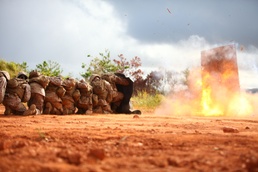
OKLINAWA, Japan - “Five, four, three, two, one — fire in the hole!” A moment later, the live ordnance explodes and a loud explosion shatters the ground and echoes through the atmosphere.
This was just another day at the office for Marines with 9th Engineer Support Battalion as they completed a demolitions training evolution, employing several types of explosives Aug. 27-29 in the Central Training Area.
The combat engineers maintained and improved demolition capabilities with common types of explosives like C-4, dynamite, TNT, bangalore torpedoes and various shaped charges during the training, according to 1st Lt. Richard J. Fitzgerald, a platoon commander with 9th ESB, 3rd Marine Logistics Group, III Marine Expeditionary Force.
“The training evolution provides newer combat engineers with a solid foundation for future training on how to handle explosives safely, so they can effectively demolish defensive obstacles,” said Fitzgerald.
During another part of the training, the Marines focused on working with the different initiation methods when firing the explosives.
“Working with nonelectric blasting caps it allows Marines to do the math to calculate the time until detonation,” said Staff Sgt. Thomas L. Heinzelman, a platoon sergeant with the battalion. “However, the biggest benefit was the hands-on training the Marines received, since most of them have not seen these types of charges since they were in (military occupational specialty) school.”
Using different explosives and methods, the combat engineers moved from a bunker to a breaching position closer to the blast for a safe but more realistic experience.
“The urban mobility breaching consisted of a stack of several Marines moving together as a team behind a protective blanket to a safe standoff from where the charge is placed on the target,” said Heinzelman.
The Marines’ proximity to the obstacle being reduced allowed the combat engineers to rapidly move through the opening that the explosives created to conduct room-clearing operations.
Urban mobility breaching is an important skill-set because it provides a unique capability for the Marine ground combat element to breach defensive obstacles, such as concertina wire, walls and entrenchments, according to Heinzelman.
The training built the Marines’ confidence preparing and detonating explosive charges.
“Confidence is important when we strive every day to prepare to fight tonight by applying the knowledge given to us in these training exercises,” said Pfc. Mario A. Velasco, a combat engineer with the battalion.
To further enhance a real-world scenario, the combat engineers spent their nights at the range, creating an opportunity to develop camaraderie within the unit during the training, according to Velasco.
“It builds unit cohesion when we are living in the same conditions and building trust in each other to do the right things, so we can execute our job safely and effectively,” said Velasco.